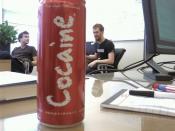Grown in the countries of South America, with Columbia being the most productive, the Erythroxylon Coca bush is the natural origin of cocaine, a central nervous stimulant. Its history is as rich and diverse as the people using and dealing the drug.
Cocaine use dates as far back as the 16th century when it was used among Inca royalty. In the early 1800's cocaine was introduced to Europe. Sigmond Freud wrote a song in its honor and famous author Robert Louis Stevenson wrote "The Strange Case of Dr. Jekyll and Mr. Hyde" during a six -day cocaine binge. In the early 1900's cocaine was available to consumers over the counter. Its medicinal value was a relief for toothaches and congestion. Parke Davis advised their consumers of the effects of cocaine by stating that it "could make the coward brave, the silent eloquent, and render the sufferer insensitive to pain".
The use of cocaine found its way into other products like wine and the most famous of all, Coca Cola.
Early production of Coca Cola contained 60mg of cocaine. Today, the popular soft drink still uses the leaves of the Coco Bush for flavor but the illicit drug has been removed (www.cocaine.org).
The resurrection of cocaine use as a recreational drug began in the 1960's, and was used mostly among the affluent because of its price. Movie stars, sport stars and the like give cocaine its mystique and draw; psychological and physical effects make it addictive. Changes in form and price make cocaine far more accessible and affordable. Today, there is no clear connection between the use of cocaine and education, occupation or socioeconomic status.
Cocaine is generally sold as a hydrochloride salt, a fine white powder substance that is commonly referred to as "snow", "coke" or "blow". Street dealers of...



A research paper on cocain, and its effects on the user
This is a great essay. Very informative and contains a lot of content. Beneficial that it has a works cited list too!
0 out of 0 people found this comment useful.